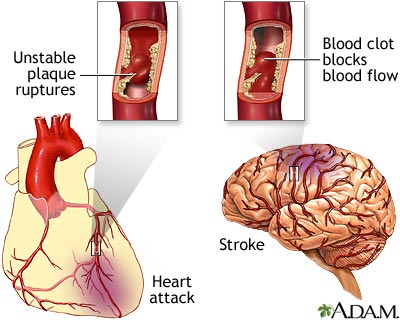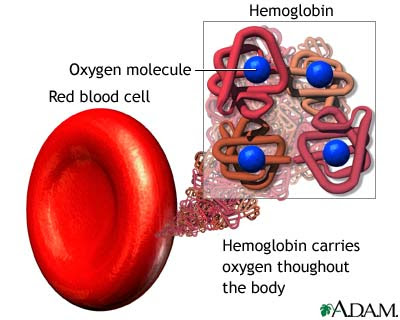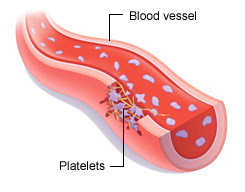Humans can't live without blood. Without blood, the body's organs
couldn't get the oxygen and nutrients they need to survive, we couldn't keep
warm or cool off, fight infections, or get rid of our own waste products.
Without enough blood, we'd weaken and die.
Blood transports oxygen and nutrients to body tissues and returns waste and carbon dioxide. Blood distributes nearly everything that is carried from one area in the body to another place within the body. For example, blood transports hormones from endocrine organs to their target organs and tissues. Blood helps maintain body temperature and normal pH levels in body tissues. The protective functions of blood include clot formation and the prevention of infection.
Bone-marrow is a soft, fatty tissue found inside of bones that produces blood cells (red blood cells, white blood cells, and platelets). Red blood cells carry oxygen throughout the body. White blood cells act to ward off infection. Platelets aid in blood-clotting.
Blood Basics
Two types of blood vessels carry blood throughout our bodies:
a) Arteries:
The coronary arteries supply blood to the heart muscle. The right coronary artery supplies both the left and the right heart; the left coronary artery supplies the left heart.
Arteries carry oxygenated blood (blood that has received oxygen from the lungs) from the heart to the rest of the body.
Plaque buildup in arteries
A heart attack or stroke may occur when an area of plaque (atherosclerosis) ruptures and a clot forms over the location, blocking the flow of blood to the organ's tissues.
b) Veins:
Blood then travels through veins back to the heart and lungs, where it receives more oxygen.
As the heart beats, you can feel blood traveling through the body at pulse points — like the neck and the wrist — where large, blood-filled arteries run close to the surface of the skin.
The blood that flows through this network of veins and arteries is whole blood, which contains three types of blood cells:
- Red Blood Cells (RBCs)
- White Blood Cells (WBCs)
- Platelets
In babies and young kids, blood cells are made within the bone marrow (the soft tissue inside of bones) of many bones throughout the body. But, as kids get older, blood cells are made mostly in the bone marrow of the vertebrae (the bones of the spine), ribs, pelvis, skull, sternum (the breastbone), and parts of the humerus (the upper arm bone) and femur (the thigh bone).
The cells travel through the circulatory system suspended in a yellowish fluid called plasma, which is 90% water and contains nutrients, proteins, hormones, and waste products. Whole blood is a mixture of blood cells and plasma.
Red Blood Cells
Red blood cells (also called erythrocytes) are shaped like slightly indented, flattened disks. RBCs contain the iron-rich protein hemoglobin. Blood gets its bright red color when hemoglobin picks up oxygen in the lungs. As the blood travels through the body, the hemoglobin releases oxygen to the tissues.
The body contains more RBCs than any other type of cell, and each has a life span of about 4 months. Each day, the body produces new RBCs to replace those that die or are lost from the body.
White Blood Cells
White blood cells (also called leukocytes) are a key part of the body's system for defending itself against infection. They can move in and out of the bloodstream to reach affected tissues. Blood contains far fewer WBCs than red blood cells, although the body can increase WBC production to fight infection. There are several types of WBCs, and their life spans vary from a few days to months. New cells are constantly being formed in the bone marrow.
Several different parts of blood are involved in fighting infection. White blood cells called granulocytes and lymphocytes travel along the walls of blood vessels. They fight germs such as bacteria and viruses and may also attempt to destroy cells that have become infected or have changed into cancer cells.
Certain types of WBCs produce antibodies, special proteins that recognize foreign materials and help the body destroy or neutralize them. The white cell count (the number of cells in a given amount of blood) in someone with an infection often is higher than usual because more WBCs are being produced or are entering the bloodstream to battle the infection.
After the body has been challenged by some infections, lymphocytes "remember" how to make the specific antibodies that will quickly attack the same germ if it enters the body again.
Platelets
Platelets (also called thrombocytes) are tiny oval-shaped cells made in the bone marrow. They help in the clotting process. When a blood vessel breaks, platelets gather in the area and help seal off the leak. Platelets survive only about 9 days in the bloodstream and are constantly being replaced by new cells.
Important proteins called clotting factors are critical to the clotting process. Although platelets alone can plug small blood vessel leaks and temporarily stop or slow bleeding, the action of clotting factors is needed to produce a strong, stable clot.
Platelets forming a clot
The body has a normal process that creates new platelets and destroys old platelets. This process keeps the right number of platelets in your blood. In people with ITP, the process is not working the way it normally does.
Platelets and clotting factors work together to form solid lumps to seal leaks, wounds, cuts, and scratches and to prevent bleeding inside and on the surfaces of our bodies. The process of clotting is like a puzzle with interlocking parts. When the last part is in place, the clot happens — but if even one piece is missing, the final pieces can't come together.
When large blood vessels are severed (or cut), the body may not be able to repair itself through clotting alone. In these cases, dressings or stitches are used to help control bleeding.
Nutrients in the Blood
Blood contains other important substances, such as nutrients from food that has been processed by the digestive system. Blood also carries hormones released by the endocrine glands and carries them to the body parts that need them.
Blood is essential for good health because the body depends on a steady supply of fuel and oxygen to reach its billions of cells. Even the heart couldn't survive without blood flowing through the vessels that bring nourishment to its muscular walls.
Blood also carries carbon dioxide and other waste materials to the lungs, kidneys, and digestive system to be removed from the body.
Blood cells and some of the special proteins blood contains can be replaced or supplemented by giving a person blood from someone else via a transfusion. In addition to receiving whole-blood transfusions, people can also receive transfusions of a particular component of blood, such as platelets, RBCs, or a clotting factor. When someone donates blood, the whole blood can be separated into its different parts to be used in this way.
Diseases of Red Blood Cells
Most of the time, blood functions without problems, but sometimes, blood disorders or diseases can cause illness. Diseases of the blood that commonly affect kids can involve any or all of the three types of blood cells. Other types of blood diseases affect the proteins and chemicals in the plasma that are responsible for clotting.
The most common condition affecting RBCs is anemia, a lower-than-normal number of red cells in the blood. Anemia is accompanied by a decrease in the amount of hemoglobin. The symptoms of anemia — such as pale skin, weakness, a fast heart rate, and poor growth in infants and children — happen because of the blood's reduced capacity for carrying oxygen.
Anemia typically is caused by either inadequate RBC production or unusually rapid RBC destruction. In severe cases of chronic anemia, or when a large amount of blood is lost, someone may need a transfusion of RBCs or whole blood.
Anemia resulting from inadequate RBC production. Conditions that can cause a reduced production of red blood cells include:
- Iron deficiency anemia. The most common type of anemia, it affects kids and teens of any age who have a diet low in iron or who've lost a lot of RBCs (and the iron they contain) through bleeding. Premature babies, infants with poor nutrition, menstruating teenage girls, and those with ongoing blood loss due to illnesses such as inflammatory bowel disease are especially likely to have iron deficiency anemia.
- Lead poisoning. When lead enters the body, most of it goes into RBCs where it can interfere with the production of hemoglobin. This can result in anemia. Lead poisoning can also affect — and sometimes permanently damage — other body tissues, including the brain and nervous system. Although lead poisoning is much less common now, it still is a problem in many larger cities, especially where young children might ingest paint chips or the dust that comes from lead-containing paints peeling off the walls in older buildings.
- Anemia due to chronic disease. Kids with chronic diseases (such as cancer or human immunodeficiency virus infection) often develop anemia as a complication of their illness.
- Anemia due to kidney disease. The kidneys produce erythropoietin, a hormone that stimulates production of red cells in the bone marrow. Kidney disease can interfere with the production of this hormone.
Anemia resulting from unusually rapid red blood cell destruction. When RBCs are destroyed more quickly than normal by disease (a process called hemolysis), the bone marrow will make up for it by increasing production of new red cells to take their place. But if RBCs are destroyed faster than they can be replaced, a person will develop anemia.
Several causes of increased red blood cell destruction can affect kids:
- G6PD deficiency. G6PD is an enzyme that helps to protect red blood cells from the destructive effects of certain chemicals found in foods and medications. When the enzyme is deficient, these chemicals can cause red cells to hemolyze, or burst. G6PD deficiency is a common hereditary disease among people of African, Mediterranean, and Southeast Asian descent.
- Hereditary spherocytosis is an inherited condition in which RBCs are misshapen (like tiny spheres, instead of disks) and especially fragile because of a genetic problem with a protein in the structure of the red blood cell. This fragility causes the cells to be easily destroyed.
- Autoimmune hemolytic anemia. Sometimes — because of disease or for no known reason — the body's immune system mistakenly attacks and destroys RBCs.
- Sickle cell anemia, most common in people of African descent, is a hereditary disease that results in the production of abnormal hemoglobin. The RBCs become sickle shaped, they cannot carry oxygen adequately, and they are easily destroyed. The sickle-shaped blood cells also tend to abnormally stick together, causing obstruction of blood vessels. This blockage in the blood vessels can seriously damage organs and cause bouts of severe pain.
===============OOooOO===============














No comments:
Post a Comment